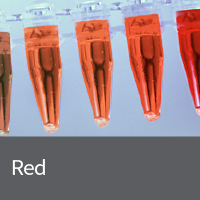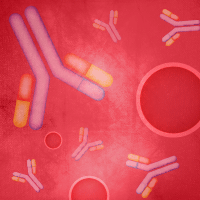tdTomato fluorescent protein

tdTomato is an exceptionally bright red fluorescent protein—6X brighter than EGFP. tdTomato's emission wavelength (581 nm) and brightness make it ideal for live animal imaging studies. The tdTomato fluorescent protein is as photostable as mCherry (Shaner et al. 2004). Sequence mutations were introduced into a monomeric variant of DsRed through directed evolution by the Tsien lab in order to produce tdTomato.
tdTomato is an exceptionally bright red fluorescent protein—6X brighter than EGFP. tdTomato’s emission wavelength (581 nm) and brightness make it ideal for live animal imaging studies. The tdTomato fluorescent protein is as photostable as mCherry (Shaner et al. 2004). Sequence mutations were introduced into a monomeric variant of DsRed through directed evolution by the Tsien lab in order to produce tdTomato. This very bright red fluorescent protein was made even brighter by creating a tandem dimer version, the tdTomato fluorescent protein. Because tdTomato forms an intramolecular dimer, it is considered monomeric (Shaner et al. 2004).
Overview
- Exceptional brightness: the brightest commercially available red fluorescent protein
- Rapid maturation (t0.5=1 hr) (Shaner et al. 2004)
- Monomeric: Nonaggregating tandem dimer structure
- Excitation maximum: 554 nm
Emission maximum: 581 nm - Lentiviral (pLVX-) formats available
More Information
Applications
- Creating fusion proteins
You may consider the mCherry fluorescent protein - Promoter-reporter studies
- FRET and other quantitative imaging techniques
- Identify and select transfected cells with the IRES tdTomato vector
- Use tdTomato fluorescent protein for in vivo studies:
- Transgenic mice—tdTomato is easily detectable in SCID mice, where fur is an additional impedance to fluorescence signal penetration (Winnard, Kluth, and Raman 2006)
- Xenograft and transplantation studies
- In vivo imaging and cell morphology analysis
- Cell-lineage tracing
References
Shaner, N. C. et al. Improved monomeric red, orange and yellow fluorescent proteins derived from Discosoma sp. red fluorescent protein. Nat. Biotechnol. 22, 1567–72 (2004).
Winnard, P. T., Kluth, J. B. & Raman, V. Noninvasive optical tracking of red fluorescent protein-expressing cancer cells in a model of metastatic breast cancer. Neoplasia 8, 796–806 (2006).
Additional product information
Please see the product's Certificate of Analysis for information about storage conditions, product components, and technical specifications. Please see the Kit Components List to determine kit components. Certificates of Analysis and Kit Components Lists are located under the Documents tab.
Fluorescent protein related links
Takara Bio USA, Inc.
United States/Canada: +1.800.662.2566 • Asia Pacific: +1.650.919.7300 • Europe: +33.(0)1.3904.6880 • Japan: +81.(0)77.565.6999
FOR RESEARCH USE ONLY. NOT FOR USE IN DIAGNOSTIC PROCEDURES. © 2025 Takara Bio Inc. All Rights Reserved. All trademarks are the property of Takara Bio Inc. or its affiliate(s) in the U.S. and/or other countries or their respective owners. Certain trademarks may not be registered in all jurisdictions. Additional product, intellectual property, and restricted use information is available at takarabio.com.




